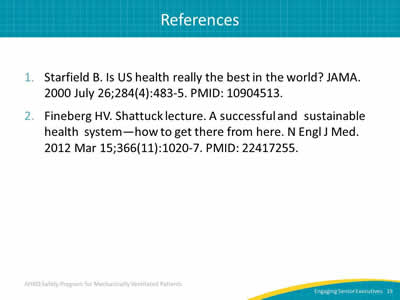Engaging Senior Executives in Care of Mechanically Ventilated Patients: Facilitator's Guide
AHRQ Safety Program for Mechanically Ventilated Patients
Slide 1: Engaging Senior Executives in Care of Mechanically Ventilated Patients
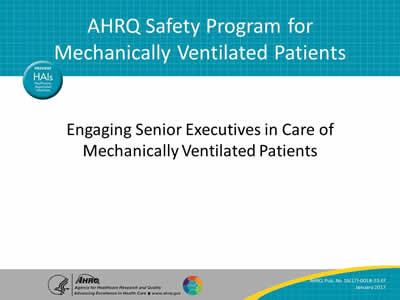
Say:
In this module, we will discuss the importance of senior executive engagement on your safety program team.
Slide 2: Learning Objectives
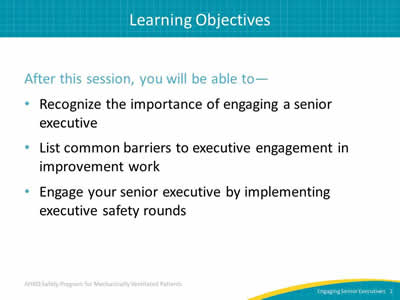
Say:
After this session, you will be able to recognize the importance of engaging a senior executive, list common barriers to executive engagement in improvement work, and engage your senior executive by implementing executive safety rounds.
Slide 3: To Err Is Human
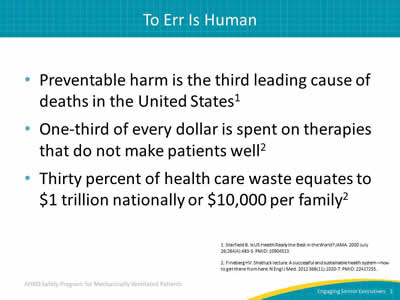
Say:
It has been more than 15 years since the release of the Institute of Medicine’s (now known as the National Academy of Medicine) groundbreaking report, "To Err is Human: Building a Safer Health System." Still, despite that wakeup call, preventable harm is the third leading cause of death in the United States. One-third of every dollar spent on health care is wasted on therapies that do not make patients well. That 30 percent of health care waste equates to $1 trillion nationally or $10,000 per American family.
Slide 4: Comprehensive Unit-based Safety Program (CUSP)
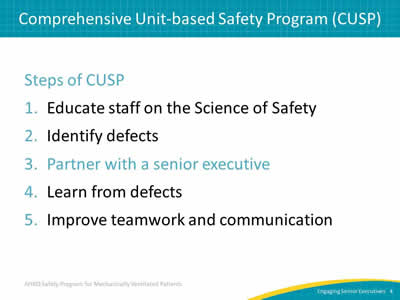
Say:
The CUSP program is your anchor of health care culture improvement. It is a five-part, iterative process. It begins with five steps. First, educate your staff on the Science of Safety. Second, identify defects. The third step is partnering with a senior executive. The fourth is learning from your defects. Finally, the fifth step is improving teamwork and communication.
In this module, we will focus on step three—partner with a senior executive.
Slide 5: Why Do We Need an Executive?
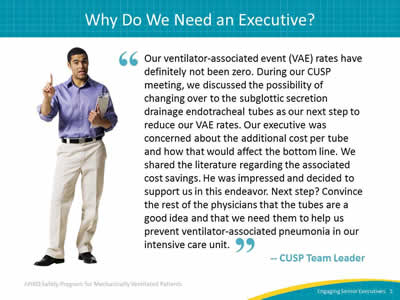
Say:
Sometimes getting executives involved in a patient safety project is one of the most challenging aspects of the project.
Ask:
Have you ever been a part of safety and quality improvement efforts that were undermined by very small things (like the cost of equipment in the example) outside of your control?
Say:
Most of us have. That is where the executive partner can help immensely by seeing the larger picture.
Slide 6: Executive Partnership—Win-Win
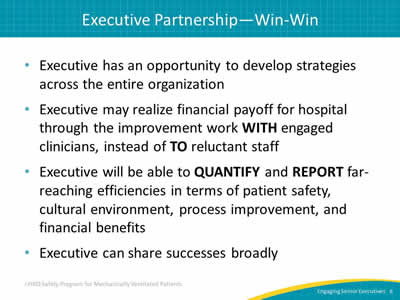
Say:
Another way to view the senior executive partner is as a liaison to other leaders. In most if not all hospitals, no single person has supreme authority over all aspects of the organization. Your work likely will touch many interrelated departments, processes, and policies. It can be a challenge for frontline staff and unit-level leaders to recognize all stakeholders. Executive partners usually do have that knowledge and hopefully working relationships with these different leaders.
This is similar to the idea of rotating in different types of clinical expertise as the focus of your team evolves over time. For example, with mechanical ventilation safety, respiratory therapists need a strong presence. If you are working on medication-related issues, pharmacy should be a key player. The same is true of executive leaders. When the team’s focus includes a specific area of the organization, the executive leader of that area should be engaged at some level.
Safety work has some additional benefits that executives recognize. In many ways, safety teams are engines of innovation. They identify problems and generate solutions. As they implement and evaluate, they find out what works. These lessons can be shared broadly across the organization. The executive can play a key role in this transition from a local solution to something that benefits the whole system. This knowledge sharing and innovation are necessary to keep pace with the rate of change in health care today.
Executives are well positioned to share these stories within and outside the organization, as well as vertically and horizontally within the organization, such as at department meetings, executive meetings, board meetings, industry conferences, local business networking events, et cetera. This storytelling is a key approach to managing culture in an organization because it demonstrates and reinforces the values and capabilities of the organization. Use this powerful approach!
Ask:
Currently, do you have mechanisms to systematically capture and share lessons learned and successes in safety and quality improvement?
Say:
Your safety program work can be a key component of this infrastructure.
Slide 7: What Does an Executive Offer?
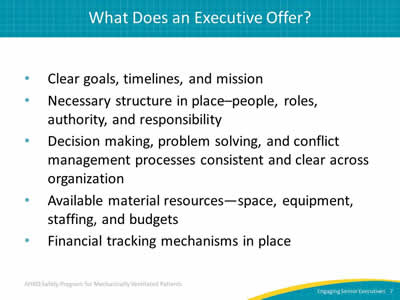
Ask:
But, what’s in it for the team?
Say:
Many things. As we have discussed in the examples above, the executive serves to support the frontline team with guidance, advice, connections to other stakeholders, and material resources when necessary. In particular, the senior executive brings an alignment with the broader goals of the organization. The connection with other stakeholders can open lines of communication and reduce perceived barriers to improvement efforts.
Slide 8: Barriers to Executive Engagement
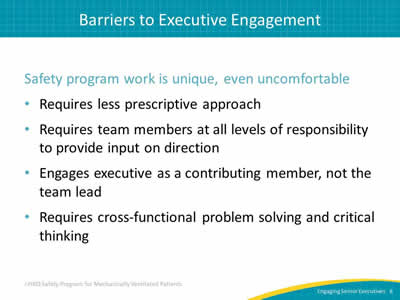
Say:
This safety program empowers frontline staff rather than taking a top-down hierarchical approach.
Many of you may have strong executive partnerships in place already. They are becoming more common. If you have an executive partner, you might also have experienced some of these challenges. If an executive partnership is a new relationship for your team, these issues might surface as you work to recruit and engage an executive.
First, this program includes a structured process, but it is less prescriptive than some initiatives.
It involves "building your own bundle" and not implementing an "off the shelf" set of rules or instructions. We have found that there is not one solution that will fit everyone’s needs.
Second, as the mechanical ventilation safety program is about culture change as well as technical improvement, this process emphasizes input from all levels and types of expertise. Most executive leaders want to have this type of culture—in which everyone feels comfortable speaking up, participates, and believes they have input valuable to the team. However, not all leaders are great at building this culture. It can be difficult, and very few people are trained on how to do it. Leaders are expected to lead and make decisions. However, in safety program teams, the executive is only one of many perspectives represented in decisionmaking.
Third, the executive partner is a core member of the team but is not there to lead the team. This may be an unusual role for an executive, but that person is there to support frontline team members, who have the best understanding of how their system works and how it can be improved.
Many executives are in the habit of "running the show," and that habit can be tough to break. In much of their work, they are expected to lead the way, but this team has different expectations. We ask them to support, coach, mentor, provide guidance, and help connect the team to the broader organization’s goals and priorities as well as allocate necessary resources (time, personnel, equipment, supplies, et cetera).
Fourth, the safety team requires a cross-functional approach to problem solving and critical thinking. The team will identify safety-related priorities on the unit and work to solve them. Real solutions almost always require input from everyone. We are not all used to working in this setting. Coming to a common understanding of the problem and why different solution options may or may not be viable for everyone can be challenging. It can take additional upfront time.
Keep in mind, you do not necessarily know what is coming in safety program work. All teams will encounter surprises along the way. A good team will use these surprises as opportunities to improve or strengthen. The work will uncover new insights into how the unit works, what the challenges are, and what solutions are needed. It is much easier to engage someone (anyone, not just executives) if you can be clear about what will happen.
Ask:
Which of these barriers have you experienced in your work?
How did you overcome them?
Say:
We’ll talk about approaches to address these barriers throughout the rest of the module.
Slide 9: Addressing Executive Concerns
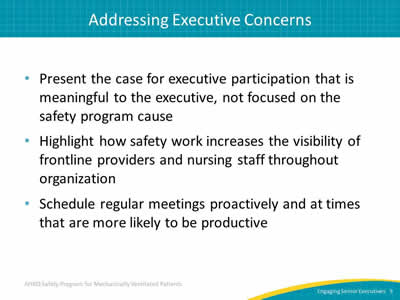
Say:
Like the rest of us, executives have many competing priorities. Many people in the organization ask for their time. So, we need to make a compelling case that participating in this safety program is both necessary and valuable.
Ask:
What do you think your executive leaders value and prioritize most?
What do you think drives their decisions about how they allocate their time and effort?
Say:
When we work in multidisciplinary teams, it is important to understand other people’s perspectives and priorities. We want the executive to better understand the pressures and challenges frontline teams face, but we also have to take the executive’s perspective to understand his or her work and ways the team can support the executive’s goals. Partnering with executives or anyone else is not a one-way street. When we think about engaging people in our work, we need to start from where they are and highlight ways different stakeholders will benefit.
While everyone’s organization will be a bit different, here are some common realities to think about when reaching out to executive partners.
Ask:
Do you think the executive would be interested in strengthening relationships with the physicians?
Say:
Most executives will be interested in building a closer working relationship with physicians.
Second, this point extends to all staff. Executives are increasingly aware that developing a safety culture is a part of their job. This awareness requires them to be more visible and accessible to frontline staff. The CUSP components of this safety program can be a way to make this happen in a structured, predictable, and solution-focused way. Executives can be seen in a positive light and can accomplish their goals in an efficient way.
Third, schedule meetings far in advance and at times the executive can attend. Be aware of recurring demands on the executive’s time and work around them. For example, do not schedule a team meeting the afternoon before a monthly board meeting; executive attention will be diverted to board meeting preparations.
However, scheduling regular meetings the week before high-level meetings will provide the executive with great information and perhaps excitement to share. Avoid scheduling conflicts such as meetings that regularly run over, tend to be acrimonious, or are particularly intense. Executive attendance and attention will be ongoing challenges if these logistics are ignored.
Slide 10: Engaging Your Executive
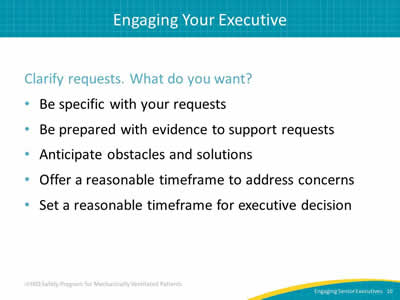
Say:
Be clear with requests. If your executive is actively engaged in your team meetings, the need for a resource should be clear and, hopefully, your executive was a part of the discussion delineating that need. But, before you ask an executive for a resource—either time or materials, clarify exactly what you need.
Be prepared with evidence to support your requests. Make sure your senior executive has the information necessary to make an informed decision or present the request to a higher authority. Decisions about a certain expenditure amount very well may require additional support. Proper preparation will allow your executive to proceed with confidence and support.
Through tools like the Staff Safety Assessment (SSA), this program is all about anticipating obstacles and problem solving. The same is true for this aspect of the project. Anticipate obstacles and relevant solutions for any resource request. Keep momentum moving forward by anticipating and answering these questions.
Do not expect a decision immediately. Be clear about the deadline for a decision and provide alternatives where possible. The executive is not an all-powerful magician. Give the executive the chance to build organizational support and resources for major decisions.
Slide 11: Executive Safety Rounds Kickoff
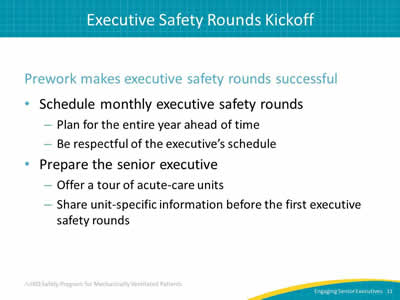
What does it look like to have an executive partner on your team?
Say:
We have to overcome the notion of a hierarchy that keeps anyone who is not a clinician or who has not actually worked in the intensive care unit, or ICU, or with mechanically ventilated patients from contributing to its functioning. Increasingly, executives across the country are not only willing to cross the line to come in and see you in your space, they are eager for you to invite them to do just that.
A little preparatory work can make executive engagement easier to maintain. Executives remain engaged when their time is valued. Before the first ICU tour, share unit-specific information with the executive. The additional context will make the tour more meaningful and will likely allow for deeper questions and engagement.
Schedule monthly executive safety rounds ahead of time for the entire year. Be respectful of the executive’s schedule and keep meetings on schedule. Start promptly and manage time during the meeting/tour. Be prepared to wrap up the event on schedule. Keep discussions applicable to the group; suggest topics go offline when necessary to keep the group on task.
Slide 12: Executive Safety Rounds Kickoff
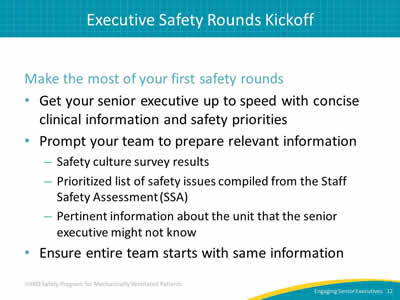
Say:
Every chief executive officer or CEO in the country wants to believe that his or her hospital is the best. Sometimes being able to share data that indicate vulnerabilities or opportunities to improve gives the CEO a focus and provides a chance to see the importance of the CEO’s own role as a quality improvement and safety program team member.
A kickoff meeting can set the stage for developing this kind of understanding. Consider sharing the following at the meeting:
- Patient safety culture survey results.
- The prioritized the list of safety issues your team has compiled based on an SSA—asking how will the next patient be harmed by a ventilator-associated event (VAE) and what can be done to prevent this harm.
- Unit-specific information, such as—
- Your staff turnover rate.
- Your VAE rate.
- Data from National Healthcare Safety Network (NHSN).
- Your staff’s views on what makes your ICU unique and/or what your staff is proud of.
Slide 13: Executive Safety Rounds Kickoff
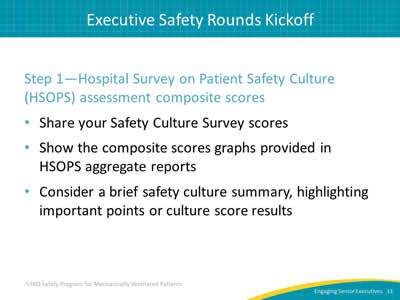
Say:
Step 1—Hospital Survey on Patient Safety Culture assessment composite scores:
- Share your Safety Culture Survey (HSOPS) scores.
- HSOPS aggregate report provides composite scores graphs.
- Consider a brief safety culture summary, highlighting important points or culture score results.
Ask:
Do you know how to access your HSOPS aggregate report?
Slide 14: Executive Safety Rounds Kickoff
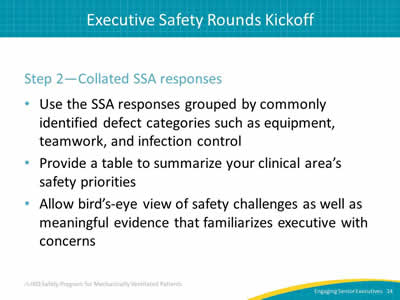
Say:
Step 2—Collated SSA responses.
Use the SSA responses grouped by commonly identified defect categories such as equipment, teamwork, and infection control. Provide a table to summarize your clinical area’s safety priorities. Allow a bird’s-eye view of safety challenges as well as meaningful evidence that familiarizes executive with concerns.
Optional: Consider building on staff’s suggestions for improvement with specific recommendations for your senior executive.
Slide 15: Executive Safety Rounds Kickoff
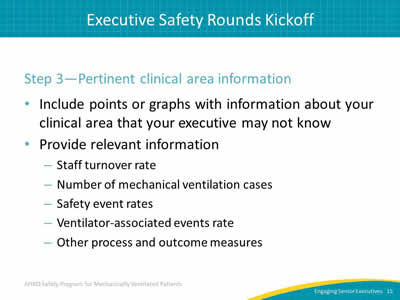
Ask:
For those of you with an executive partner already, how well does that person know your unit?
Does he or she know your unit’s key priorities?
What about your VAE rates?
Say:
Do not make assumptions about what your executive partner knows. Share the basic structural information (number of rooms, average number of cases, types of cases, et cetera) as well as safety- and quality-related information. Have detailed information ready but provide a 1- or 2-page summary to highlight key features of the unit, areas of strength, and priorities from various sources (outcome or process data, culture data, et cetera).
Slide 16: Executive Safety Rounds Kickoff
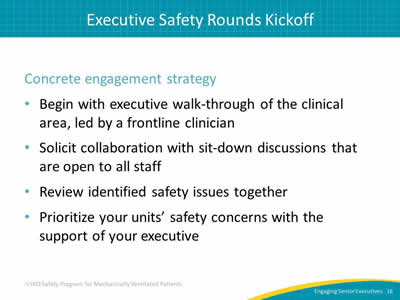
Say:
It is important that you solicit collaboration with your executives. Do not just invite them to come to the unit and walk through the ICU with you. In addition, find a space—the staff lounge or a conference room you typically use—where there can be real conversation with your senior executive. Everyone should be able to take part in the conversation around this project in a nonthreatening, easygoing, and conversational way.
This does not happen without preplanning and a strong and consistent communication process with the entire staff. Meetings will be far more productive with an agenda to help guide the discussion and keep the meeting on task. Again, tap the wisdom of your frontline staff and prioritize your units’ safety concerns with the support of your executive.
Slide 17: Executive Safety Rounds Kickoff
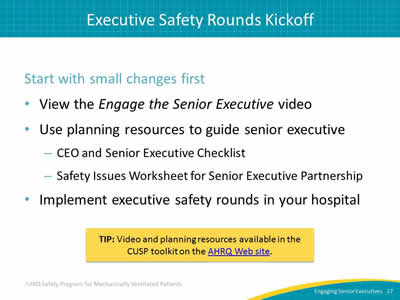
Say:
Watch the video titled Engaging the Senior Executive, found on the AHRQ Web site in the CUSP toolkit. The 6½-minute video focuses on bridging the gap between senior management and frontline providers to facilitate a system-level perspective on quality and safety challenges that exist at the unit level.
The first meeting is very important for engaging your senior executive. You can use the CEO and Senior Executive Checklist for suggested activities and talking points. The Safety Issues Worksheet for Senior Executive Partnership provides your senior executive a tool to note patient safety issues observed during safety rounds.
Finally, schedule your executive safety rounds for the next year!
Slide 18: Questions

Say:
Are there any questions after viewing this module?
Slide 19: References
